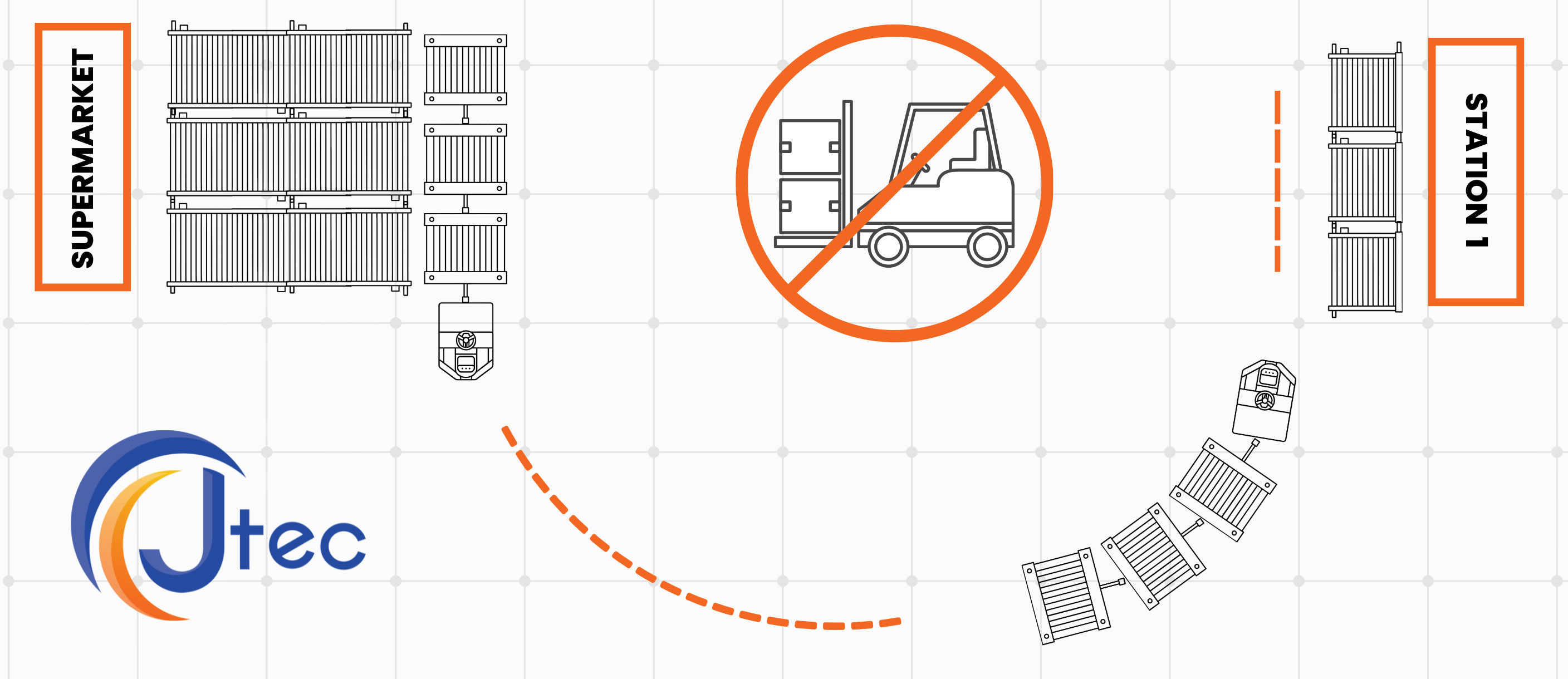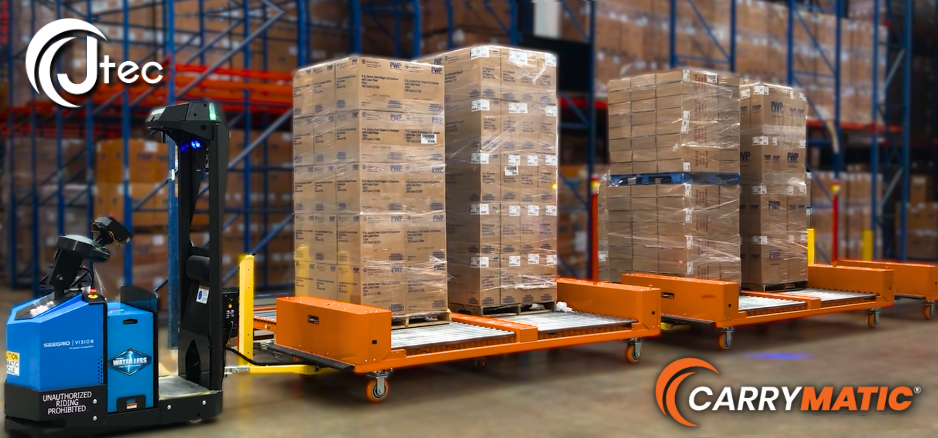When critical parts are late to the assembly line, production can grind to a halt as your team scrambles to find missing components. These issues, and more, are a the daily reality for facilities struggling with inefficient milk run execution. These seemingly small disruptions – the late cart, the disorganized route, the difficulty in tracking inventory – add up to significant losses in time, money, and overall productivity.
At Jtec Industries, we understand these challenges intimately. We recognize that a smooth, reliable material flow is the lifeblood of efficient operations. That’s why we’ve dedicated ourselves to providing comprehensive solutions that go beyond simply moving materials from point A to point B.
When critical parts are late to the assembly line, production can grind to a halt as your team scrambles to find missing components. These issues, and more, are a the daily reality for facilities struggling with inefficient milk run execution. These seemingly small disruptions – the late cart, the disorganized route, the difficulty in tracking inventory – add up to significant losses in time, money, and overall productivity.
At Jtec Industries, we understand these challenges intimately. We recognize that a smooth, reliable material flow is the lifeblood of efficient operations. That’s why we’ve dedicated ourselves to providing comprehensive solutions that go beyond simply moving materials from point A to point B.
Understanding the Challenge: Where Do Milk Runs Go Wrong?
A milk run is designed to be a lean and efficient system for delivering and collecting materials throughout a facility. They can quickly become a source of bottlenecks and frustration if not planned and executed with precision. Common failure points include:
1) Inefficient Routing
When milk run routes aren’t thoughtfully designed, they often result in wasted motion and excessive travel time. Drivers may find themselves circling the same zones multiple times a shift, making unnecessary stops, or being forced to backtrack due to poorly sequenced delivery points. This lack of efficiency leads to missed windows for timely material delivery, disrupts the rhythm of production, and contributes to operator fatigue. Over time, these compounded inefficiencies create a pattern of unreliability that can undermine trust in the entire delivery system.
2) Lack of Real-Time Visibility
Without access to up-to-the-minute information about cart locations, material status, or route progress, teams are left guessing. Line workers may assume material is en route when it hasn’t even left the supermarket. This disconnect leads to fire-fighting behavior—phone calls and time-consuming physical searches—all of which pull workers away from value-added tasks. There are ways to get real-time visibility many are unaware of.
3) Manual Tracking Errors
Relying on pen-and-paper checklists, memory, or informal verbal confirmation opens the door to frequent and often unnoticed mistakes. A cart may skip a stop without anyone realizing it, or an operator may mark a delivery as complete despite missing a container. Over time, these errors accumulate—causing inaccurate inventory records, material shortages, and discrepancies that trigger audits or line stoppages. The more manual the system, the more room there is for human error, particularly under pressure or during shift changes.
4) Inadequate Cart Systems
Using carts that don’t match the operational demands of your facility creates daily problems that are both safety-related and productivity-draining. Overloaded or unbalanced carts can tip, damage parts, or injure workers. A lack of standardization leads to guesswork about what cart should be used for which task. When carts are limited in quantity or poorly maintained, teams begin hoarding them or improvising, further complicating flow and creating friction across departments.
5) Poor Communication
Even the most carefully planned milk run can fall apart if communication between departments is inconsistent or unclear. Materials may be staged in the wrong location, operators may not be informed of schedule changes, and production teams may not signal their needs in a timely manner. These gaps create confusion and frustration—leading to missed pickups, wrong deliveries, and wasted time resolving issues that could have been avoided with clear, shared expectations. The result is often a blame game culture and a breakdown in team cohesion.
The consequences of these failures ripple throughout your organization, impacting everything from production schedules to your bottom line. Unresolved, these issues can lead to missed deadlines, increased operational costs, and a diminished ability to compete effectively.
A milk run is designed to be a lean and efficient system for delivering and collecting materials throughout a facility. They can quickly become a source of bottlenecks and frustration if not planned and executed with precision. Common failure points include:
1) Inefficient Routing
When milk run routes aren’t thoughtfully designed, they often result in wasted motion and excessive travel time. Drivers may find themselves circling the same zones multiple times a shift, making unnecessary stops, or being forced to backtrack due to poorly sequenced delivery points. This lack of efficiency leads to missed windows for timely material delivery, disrupts the rhythm of production, and contributes to operator fatigue. Over time, these compounded inefficiencies create a pattern of unreliability that can undermine trust in the entire delivery system.
2) Lack of Real-Time Visibility
Without access to up-to-the-minute information about cart locations, material status, or route progress, teams are left guessing. Line workers may assume material is en route when it hasn’t even left the supermarket. This disconnect leads to fire-fighting behavior—phone calls and time-consuming physical searches—all of which pull workers away from value-added tasks. There are ways to get real-time visibility many are unaware of.
3) Manual Tracking Errors
Relying on pen-and-paper checklists, memory, or informal verbal confirmation opens the door to frequent and often unnoticed mistakes. A cart may skip a stop without anyone realizing it, or an operator may mark a delivery as complete despite missing a container. Over time, these errors accumulate—causing inaccurate inventory records, material shortages, and discrepancies that trigger audits or line stoppages. The more manual the system, the more room there is for human error, particularly under pressure or during shift changes.
4) Inadequate Cart Systems
Using carts that don’t match the operational demands of your facility creates daily problems that are both safety-related and productivity-draining. Overloaded or unbalanced carts can tip, damage parts, or injure workers. A lack of standardization leads to guesswork about what cart should be used for which task. When carts are limited in quantity or poorly maintained, teams begin hoarding them or improvising, further complicating flow and creating friction across departments.
5) Poor Communication
Even the most carefully planned milk run can fall apart if communication between departments is inconsistent or unclear. Materials may be staged in the wrong location, operators may not be informed of schedule changes, and production teams may not signal their needs in a timely manner. These gaps create confusion and frustration—leading to missed pickups, wrong deliveries, and wasted time resolving issues that could have been avoided with clear, shared expectations. The result is often a blame game culture and a breakdown in team cohesion.
The consequences of these failures ripple throughout your organization, impacting everything from production schedules to your bottom line. Unresolved, these issues can lead to missed deadlines, increased operational costs, and a diminished ability to compete effectively.
Solutions and On-Site Support


Improving milk run performance starts with understanding the full picture—not just where materials are going, but how, when, and why delays occur. A thorough evaluation of current processes is essential. This often includes mapping routes, tracking material flow, collecting cycle-time data, evaluating cart usage, reviewing inventory systems, and gathering input from the people closest to the work.
Once a baseline is established, several key areas typically offer the greatest opportunities for improvement:
Expert Consultation
Start by examining the physical flow of materials across your facility. Jtec begins every engagement by evaluating your current processes through onsite assessments and workflow audits. Our team identifies inefficiencies, safety risks, and material flow bottlenecks, then develops a tailored improvement plan aligned with your operational goals. From the start, we act as both consultants and solution engineers.
Custom Cart Solutions
The right cart system plays a critical role in enabling efficient deliveries. Carts should match the size, weight, and frequency of the materials they carry—and be tailored to the environment they move through. We offer a full suite of engineered carts including CarryMore® mother-daughter tugger trains, heavy-duty CarryMax® trailers, and ergonomic CarryLite® carts. Each system is built to meet your specific material handling needs, whether it’s line-side delivery, over-the-road transport, or ergonomic access. Custom configurations like turntables, drawers, or foam inserts ensure optimized performance.
Autonomous Integration
For routes with repetitive or time-sensitive deliveries, automation can help reduce manual intervention and increase consistency. Our CarryMatic® system automates repetitive material transfers with AMR-compatible carts and docking stations. These solutions reduce labor requirements and enhance safety in high-frequency routes. We handle the full deployment—from layout design to commissioning and support.
Layout Optimization
Many milk run issues are rooted in layout inefficiencies—long travel distances, congested aisles, or poorly placed pickup/drop-off points. We work with your team to redesign facility flow paths, optimize station placements, and reduce non-value-added movement. Whether you’re expanding or reconfiguring, our goal is to streamline tugger routes, reduce travel time, and support lean operations.
Ongoing Support
Continuous improvement is just that—continuous. As production demands shift and processes evolve, it’s important to revisit the system regularly. Implementation is just the beginning—we provide ongoing technical support, training, and continuous improvement consulting. Our team stays engaged to help you adapt to changes, maintain uptime, and continually improve efficiency as your operations evolve.
Improving milk run performance starts with understanding the full picture—not just where materials are going, but how, when, and why delays occur. A thorough evaluation of current processes is essential. This often includes mapping routes, tracking material flow, collecting cycle-time data, evaluating cart usage, reviewing inventory systems, and gathering input from the people closest to the work.
Once a baseline is established, several key areas typically offer the greatest opportunities for improvement:
Expert Consultation
Start by examining the physical flow of materials across your facility. Jtec begins every engagement by evaluating your current processes through onsite assessments and workflow audits. Our team identifies inefficiencies, safety risks, and material flow bottlenecks, then develops a tailored improvement plan aligned with your operational goals. From the start, we act as both consultants and solution engineers.
Custom Cart Solutions
The right cart system plays a critical role in enabling efficient deliveries. Carts should match the size, weight, and frequency of the materials they carry—and be tailored to the environment they move through. We offer a full suite of engineered carts including CarryMore® mother-daughter tugger trains, heavy-duty CarryMax® trailers, and ergonomic CarryLite® carts. Each system is built to meet your specific material handling needs, whether it’s line-side delivery, over-the-road transport, or ergonomic access. Custom configurations like turntables, drawers, or foam inserts ensure optimized performance.
Autonomous Integration
For routes with repetitive or time-sensitive deliveries, automation can help reduce manual intervention and increase consistency. Our CarryMatic® system automates repetitive material transfers with AMR-compatible carts and docking stations. These solutions reduce labor requirements and enhance safety in high-frequency routes. We handle the full deployment—from layout design to commissioning and support.
Layout Optimization
Many milk run issues are rooted in layout inefficiencies—long travel distances, congested aisles, or poorly placed pickup/drop-off points. We work with your team to redesign facility flow paths, optimize station placements, and reduce non-value-added movement. Whether you’re expanding or reconfiguring, our goal is to streamline tugger routes, reduce travel time, and support lean operations.
Ongoing Support
Continuous improvement is just that—continuous. As production demands shift and processes evolve, it’s important to revisit the system regularly. Implementation is just the beginning—we provide ongoing technical support, training, and continuous improvement consulting. Our team stays engaged to help you adapt to changes, maintain uptime, and continually improve efficiency as your operations evolve.


In today’s fast-paced manufacturing environment, every delay matters. When your milk run system falters—whether due to outdated equipment, inefficient routing, or a lack of visibility—it doesn’t just cause minor inconveniences; it creates cascading disruptions that affect your entire operation. That’s why Jtec takes a comprehensive, collaborative approach—helping you move beyond reactive fixes to proactive, strategic material flow design. To learn more browse our products and reach out today.
In today’s fast-paced manufacturing environment, every delay matters. When your milk run system falters—whether due to outdated equipment, inefficient routing, or a lack of visibility—it doesn’t just cause minor inconveniences; it creates cascading disruptions that affect your entire operation. That’s why Jtec takes a comprehensive, collaborative approach—helping you move beyond reactive fixes to proactive, strategic material flow design. To learn more browse our products and reach out today.
REACH OUT
NEED MORE INFORMATION? HAVE US CONTACT YOU
Lorem ipsum dolor sit amet, consectetur adipiscing elit. Ut elit tellus, luctus nec ullamcorper mattis, pulvinar dapibus leo.
